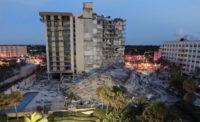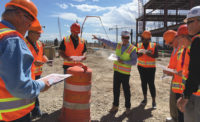Last year marked two milestones for forensic structural engineer Donald O. Dusenberry. He retired from Simpson Gumpertz & Heger Inc. after 45 years and he celebrated the completion of the draft of the nation’s first building standard on disproportionate collapse mitigation.
“It’s rewarding to create something that didn’t exist before,” says Dusenberry, who chaired a committee of about 50 other volunteers that produced the draft Disproportionate Collapse Mitigation of Building Structures Standard of the American Society of Civil Engineers/Structural Engineering Institute (SEI).
Related Article:
First US Standard on Disproportionate Collapse Coming Soon
Back to:
25 Top Newsmakers
“Until now, there has been little consensus about when a collapse is considered disproportionate to an initiating failure,” says the consulting engineer about a subject that has intrigued him since the 1990s.
The need for a standard has long been debated. “Some in the profession don’t feel it is necessary,” because disproportionate collapse is a low probability event, says Bruce Ellingwood, a professor of civil engineering at Colorado State University and a committee member. That’s why the standard will not be applied to ordinary buildings, he adds.
To create consensus, Dusenberry had to manage different opinions of many of SEI’s “heavy hitters” over a dozen years, says Ellingwood. “He is patient and persistent steering this committee,” he adds, calling Dusenberry an “outstanding” engineer.
Debate Over the Definition
There also has been debate over the definition of the term formerly known as, and still confused with, progressive collapse. The draft defines disproportionate collapse as “characterized by a pronounced disparity between the original cause and the ensuing collapse of a major part or the whole of a structure.”
The standard offers a design methodology to prevent catastrophic failure from a relatively small trigger. “If you lose a wall, maybe a floor above could collapse,” but nothing more, says Dusenberry.
The collapses of the World Trade Center towers on 9/11 were not disproportionate, he says. “I think the buildings performed well under the circumstances,” he adds.
He does consider the 1990 sinking, during renovations, of 2,800 ft of the 6,600-ft-long Lacey V. Murrow Floating-Concrete Pontoon Bridge across Lake Washington and the 1995 bombing of the Alfred P. Murrah Federal Building in Oklahoma City examples of disproportionate collapse. He says it would be unwise to speculate about the tragic failure last year at Champlain Towers South.
The Murrow bridge is his favorite probe. The failure started in one pontoon, overloaded with water stored there, and progressed in sequence.
Dusenberry has learned lessons investigating myriad failures: For spectacular failures, there is often more than one contributing cause. Don’t assume a cause even if it appears obvious. Be fair and balanced in determining causes.
Another milestone is looming for the draft standard—its release for public ballot and comment. Dusenberry expects lively discussions because the standard is new and performance-based, not prescriptive. But he is confident it will be adopted.
In case he is mistaken, the document will be issued as a guideline.






Post a comment to this article
Report Abusive Comment